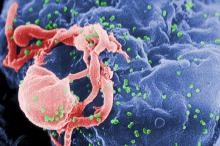Blacks/African Americans continue to bear a disproportionate burden of HIV diagnoses compared with any other racial or ethnic groups, according to data published Feb. 3 in the Centers for Disease Control and Prevention’s Morbidity and Mortality Weekly Report.
Between 2005 and 2008, blacks/African Americans accounted for 50.3% of all HIV diagnoses in 37 states reporting to the CDC through HIV surveillance systems, despite representing just 13.6% of the population in those states, the authors wrote. Additionally, in 2008 alone, the rates of HIV diagnosis among African American males and females, respectively, were 8 and 19 times the rates reported for white males and females and 2 and 4 times the rates reported for Hispanic males and females, they stated.
"In nearly every demographic and transmission category, the largest percentages of HIV diagnoses were among blacks/African Americans," the authors wrote.
For example, during the 4-year reporting period, 56.1% of HIV diagnoses were made in individuals aged 25-44 years, and of this age group, blacks/African Americans accounted for 46.4% of them. Similarly, among adolescent and adult males, blacks/African Americans accounted for the largest percentage of HIV diagnoses overall, at 44.8%, compared with 19% and 33.6% among Hispanic/Latino and white males, respectively. They also accounted for the largest percentage of HIV diagnoses in the South, at 50.1% compared with 16.5% and 31.7% among Hispanic/Latino and white males, and in the Northeast, at 42.1% compared with 28.3% and 25.5% among Hispanic/Latino and white males, the report stated.
Among females over the 4-year period, blacks/African Americans accounted for 50.3% of the HIV diagnoses overall, compared with 17.8% and 29.4% for Hispanic/Latino and white females, respectively, and they also accounted for the majority of HIV diagnoses in the South, Midwest, and Northeast, according to the report (MMWR Morb. Mortal. Wkly. Rep. 2011;60:93-8).
When assessed by transmission category, the racial disparities were most pronounced in the rates of HIV diagnoses attributed to heterosexual contact. Nearly 71% of the males in this transmission category were black/African American, while 16.3% were Hispanic/Latino, and 11% were white. Among the females, 68% of those in the heterosexual transmission category were black/African American, compared with 14.3% who were Hispanic/Latino and 15.2% who were white.
Among black/African American males, HIV transmissions were classified as male-to-male sexual contact in 61.1% of the diagnoses, heterosexual contact in 23.1%, injection drug use in 11.9%, and both male-to-male sexual contact and infection drug use in 3.6%, the analysis showed. In black/African American females, 85.2% of HIV transmissions were through heterosexual contact and 14% were through infection drug use, according to the report.
In a trend analysis for the 4 years covered by the report, rates of HIV diagnoses increased among black/African American males while trends in other race/ethnic groups and gender groups remained stable.
"Lack of knowledge of HIV status and missed opportunities to diagnose HIV in routine clinical settings are contributing factors to the HIV epidemic among blacks/African Americans," the authors wrote in their editorial comment. "Ongoing and increased HIV testing and efforts to ensure referral and access to HIV-related primary medical care are warranted," they stated, as are comprehensive approaches "that take into account patient-specific behavioral risk factors, such as having multiple sex partners and unprotected sex, in addition to underlying factors such as poverty, unequal access to health care, incarceration, lack of education, stigma, homophobia, sexism, and racism."
No conflicts of interest were reported.


